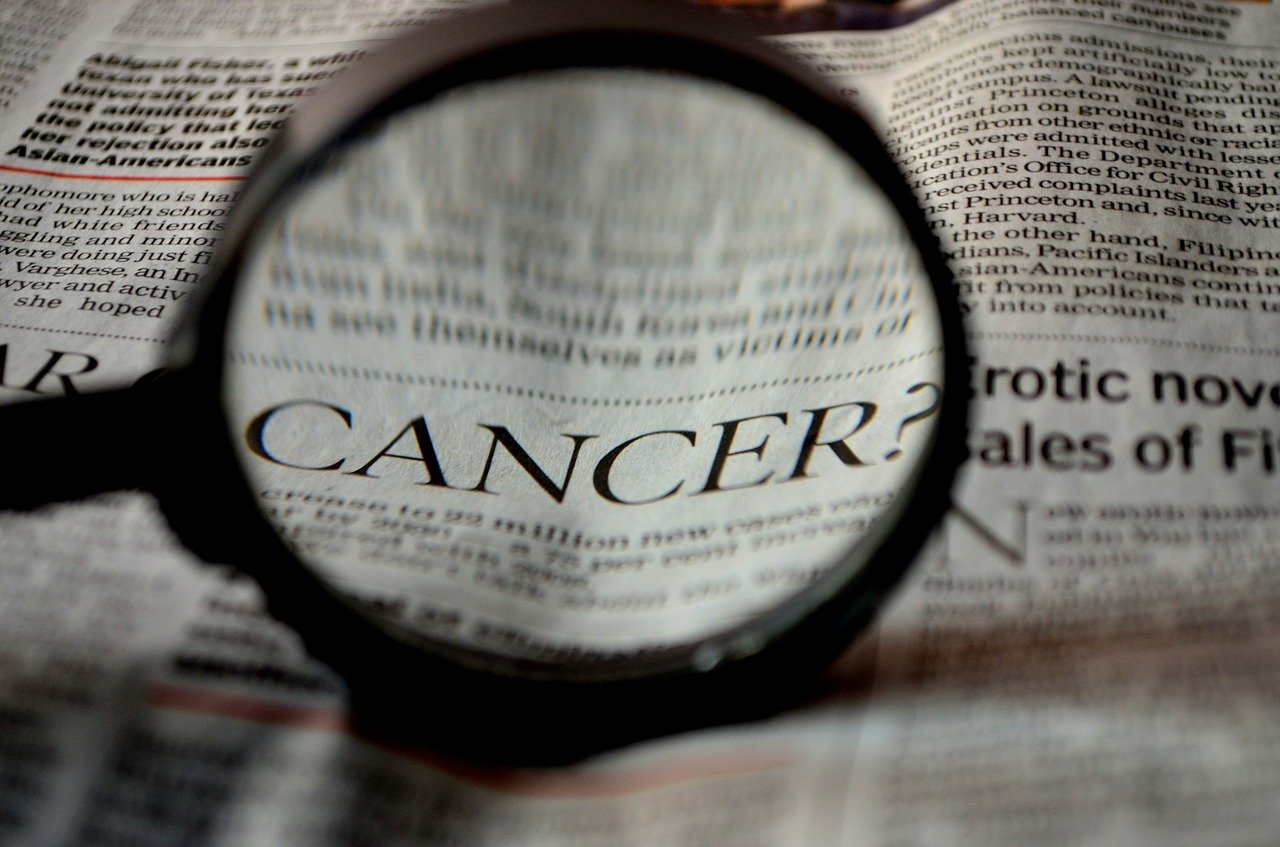Last year I launched a survey with the help of Fernando Cabo, on the perception of Shiatsu practitioners and schools of Shiatsu on a number of topics. We conducted the survey in French, English, Spanish, Italian and Portuguese. Even if the number of answers is not as high as I had hoped, they do reflect the opinions commonly heard in courses, internships and exchanges on social networks. It is now high time to reveal the data from these surveys, starting with the first, and by no means least important topic: Shiatsu and cancer. To illustrate these answers, I asked two international Shiatsu experts for their comments on this subject: Dominique Chevalier, President of the French Federation of Traditional Shiatsu (FFST) and Tzvika Calisar, founder of Seiki Shiatsu. Both of them have extensive experience of giving Shiatsu treatments to cancer patients.
First of all, I would like to thank Messrs. Cabo, Chevalier and Calisar for their commitment to Shiatsu and their courage in participating in this article.
Origins of answers
We were fortunate to have137 participants answering from 23 countries around the world.
Breakdown by language and gender

Participants by country :
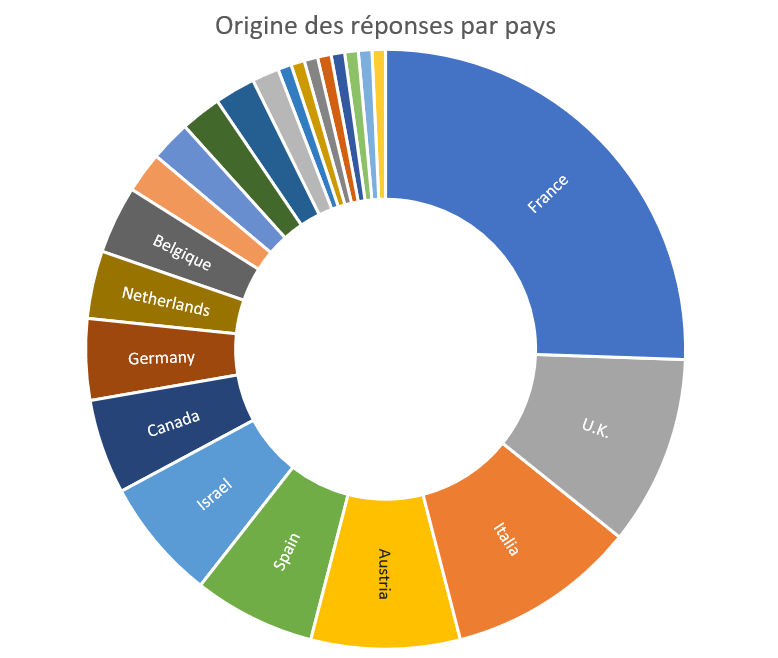
| France | 35 | Italy | 14 | U.K. | 14 |
| Austria | 11 | Israel | 9 | Spain | 9 |
| Canada | 7 | Germany | 6 | Belgium | 5 |
| Netherlands | 5 | Chile | 3 | Finland | 3 |
| Greece | 3 | U.S.A. | 3 | Switzerland | 2 |
| Australia | 1 | Benin | 1 | Czech Republic | 1 |
| Gabon | 1 | Hungary | 1 | Ireland | 1 |
| Norway | 1 | South Africa | 1 |
1st question: Do you think it is appropriate to give Shiatsu to patients with blood cancer (leukemia, myeloma, lymphoma)?
This question directly touches on one of the most widespread ideas in the world of Shiatsu: not to touch a person with blood cancer. The answers are classified by the language of the users, which allows us to evaluate how each language group perceives this question. It is interesting to note that the percentage is almost the same everywhere.
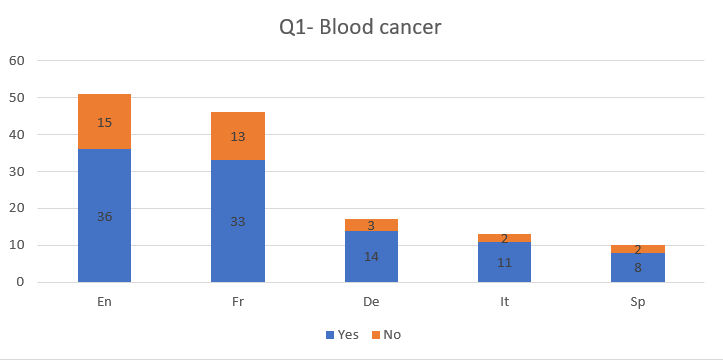
Comments:
Here are the opinions of the respondents. These have deliberately been left untranslated to avoid any risk of altering their point of view. They are classified into four categories: Yes, No, Neutral and the opinions of people experienced in this field.
| YES |
| A condition que ce soit fait avec douceur |
| Le sang et la lymphe circulent de toutes façons quoi qu’on fasse |
| Les cancéreux souffrent de nombreux autres maux qu’il faut soulager (notamment la douleur, la dépression, la fatigue…) |
| Le Ki cherche à restaurer l’équilibre, il ne peut pas blesser |
| Avec l’accord du médecin |
| NO |
| Chez ceux qui ont dit non, crainte que le sang et la lymphe circule plus vite et disperse les cellules cancéreuses |
| Dans certains pays le shiatsu pour les cancéreux est interdit |
| NEUTRAL |
| Pas de preuve scientifique que le Shiatsu diffuse le cancer du sang |
| On ne sait rien sur ce sujet |
| EXPERIENCED PEOPLE COMMENT |
| I worked in an oncology department in a major hospital in Israel for 2 years and have also worked in my private clinic with cancer patients, including blood cancer, and have seen great improvements in quality of life and physical condition. |
| Shiatsu is offered as an alternative treatment for cancer patients here in Scotland at Macmillan. It helps to address the emotional side of the illness |
| A Bruxelles nous travaillons dans un service d’oncologie avec le Shiatsu, et les médecins ne constatent que des bénéfices |
| Pratico shiatsu ai bambini del reparto oncoematologico, ottimi risultati sugli effetti collaterali da medicinali |
| Das habe ich schon gemacht und die KlientInnen fühlen sich sehr durch Shiatsu sehr gestärkt |
Question 2: Do you think it is appropriate to give shiatsu to patients with cancers other than blood cancer?
The answers here are mostly positive. This is very interesting because again 10 years ago only a few pioneers dared to treat patients with any type of cancer. So here we see a radical change in perception. This is probably due to the very many oncology centres that have opened their doors to Shiatsu throughout the world, such as the Saint-Luc University Hospital in Brussels, to name just one example.
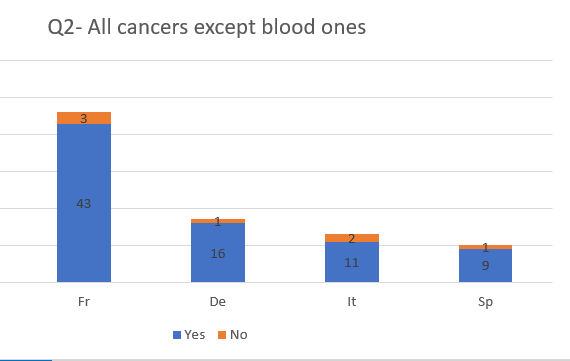
Comments:
| YES |
| Shiatsu en casos de cáncer ayuda a paliar los efectos colaterales de las terapias convencionales, apoya emocionalmente al receptor y trabaja a favor del sistema inmune. |
| Cancer is an expression of the bodymind. Shiatsu is a holistic treatment and people can benefit from receiving it. |
| You can, but you need to learn about specific cancer strategies and do’s and don’ts. |
| le shiatsu n’y est pas contre indiqué. Cependant il est préférable que ce soit un praticien expérimenté pour accompagner les personnes atteintes de cancer. J’entends expérimenté par ayant terminé son cursus de formation et pouvant faire un diagnostic énergétique précis permettant de savoir que faire et que pas faire fonction du diagnostic énergétique. |
| NO |
| It is against the law in our country (country unnamed). |
| NEUTRAL |
| Really, it depends… shiatsu moves a lot of things in the human body. Pressure might not be appropriate in some parts of the body in the case of cancer. For example, one of the three holistic systems of the body is the fascial connective tissue and this is very much stimulated by shiatsu pressure. What happens if the pressure boosts the migration of cancer cells around the body? |
| EXPERIENCED PEOPLE COMMENT |
| I have had very positive feedback from my cancer patients undergoing chemotherapy: the side-effects are easier to overcome, patients feel stronger and the poisonous pain disappears. |
| Je pratique sur cancers du poumon, les bienfaits sur la relaxation et amoindrissements des douleurs et fatigue est indéniable |
Question 3: Do you think it is appropriate to give shiatsu to patients whose chemotherapy sessions have started and are scheduled to receive more?
With regard to chemotherapy, the idea was to find out whether Shiatsu can help patients overcome the side effects of this treatment. The hundreds of practitioners with whom I have been able to talk over the past 20 years have all confirmed to me the effectiveness of Shiatsu in greatly reducing the period of pain and fatigue associated with taking chemotherapy drugs, as well as the feeling of muscle heaviness, headaches and nausea. A large majority of positive opinions in the data confirms this.

Comments:
| OUI |
| Oui et dans les limites définies par la maladie, en évitant de stimuler la zone affectée. Quoi qu’il en soit, il peut être utile d’accompagner ce type de problématique dans le cadre de leur traitement pour tenter de diminuer les effets secondaires. Je réponds à cette question par expérience. L’accompagnement des chimiothérapies par le Shiatsu est salutaire une séance 2 jours avant et une séance 2 jours après |
| Le shiatsu est excellent pour diminuer les effets secondaires de la chimiothérapie, notamment la fatigue, les maux de tête et les nausées, voire dans certains cas, la perte de cheveux. |
| Traggono benefici, allevia il dolore e gli effetti collaterali della chemio. Aiuta a riprendere forza più velocemente dopo chemio e radio. Sveglia una maggiore consapevolezza nella persona e incoraggia a prendersi cura di se. |
| Ayuda con efectos secundarios y psicologicamente |
| NO |
| La chimie fatigue beaucoup, et donc – à moins d’une demande expresse de la personne – il vaut mieux s’abstenir |
| NEUTRAL |
| Always in close consultation with the oncologist. Only start shiatsu when the chemo seems to have started working and the cancer is in remission. |
| Non ho sufficienti informazioni per trattare persone affette da cancro. Non vorrei nuocere al ricevente. |
| EXPERIENCED PEOPLE COMMENT |
| Yes! Influence over nausea, sleeping patterns and to instill a positive body image to promote healing is achieved with Shiatsu |
| Shiatsu is fantastic at helping with the side-effects of chemotherapy. Nausea, fatigue, neuropathy, blood-pressure issues, heat and sweating (in my opinion) have all responded better to Shiatsu than to the medications given alongside the Chemo. |
| Testato che da benefici su nausee, mal di testa ecc |
Question 4: Do you think it is appropriate to give shiatsu to patients who have recently received radiotherapy?
This final question asked whether respondents sensed any difference in their willingness to treat patients undergoing chemotherapy with those undergoing radiation therapy. The answers are almost identical to those in the previous question, revealing a consistency of reasoning.
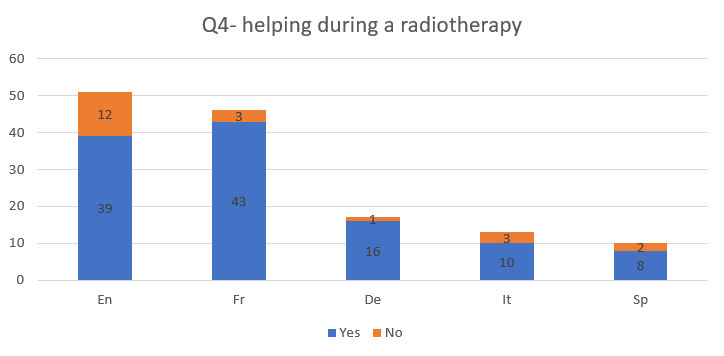
Comments are not given here, since the only interesting – and highly logical – one is not to press on the area burned by the radiotherapy rays. The other responses all refer to the previous question.
Survey conclusions
From this part of the survey regarding Shiatsu treatment for cancer, it appears that the opinions of practitioners and teachers are increasingly positive. The prevailing opinion 10 years ago, without any proof but as a precautionary principle, was not to touch people with cancer. Thanks to practitioners who responded to their patients’ requests, more and more positive opinions began to emerge. Thanks to the courage and openness of the hospitals there are also more and more experiences and convincing results.
Finally, thanks to the fundraising, promotion and collection work of the Shiatsu Research Network for scientific research in Shiatsu, we can already read 3 studies on the effects of Shiatsu on cancer :
- RELIEVING PRESSURE – AN EVALUATION OF SHIATSU TREATMENTS FOR CANCER AND PALLIATIVE CARE PATIENTS IN AN NHS SETTING. BY BROWNE & AL. (2018), London/UK
- TOUCHING CANCER: SHIATSU AS COMPLEMENTARY TREATMENT TO SUPPORT CANCER PATIENTS. BY ARGASH ET AL. (2008), PETACH TIKVA/Israel
- THE ROLE OF SHIATSU IN THE TREATMENT OF THE SIDE-EFFECTS OF CHEMOTHERAPY. BY DOMINIQUE CHEVALIER (2007), Saintes/France
Obviously, this is not enough and if Shiatsu is to continue its progress as a complementary therapy and with its recognition by national health authorities, more will be needed. This is a courageous beginning, however, and we can only salute the authors of these 3 studies for being pioneers in this field. May this encourage current practitioners to commit to entering the doors of oncology services to carry out new studies that will benefit the entire profession. I now give the floor to one of these pioneers, author of one of the three studies: Dominique Chevalier.
Comments by Dominique Chevalier
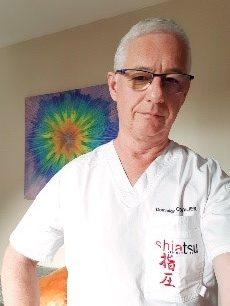
Masseur – Physiotherapist DE
Practitioner – Shiatsu Trainer
President of the French Federation of Traditional Shiatsu (FFST)
Allow me introduce myself in a few words. Physiotherapist since 1984, I worked in private practice for about ten years. I also worked with children with multiple disabilities. Then I joined a hospital team in follow-up care and rehabilitation for six years. At that time, I became aware of my own shortcomings in pain management, so I did a University diploma in Pain Management at the Bordeaux University Hospital in 2000. Then I joined a palliative care team at the Saintonge Hospital Center. At that time, I was in my 3rd year of Shiatsu training and had the opportunity to practice Shiatsu with about 150 patients undergoing chemotherapy. The objective of this treatment was to see whether Shiatsu could have an influence on the side effects of chemotherapy. The results were quite convincing, since 64% of the side effects were significantly reduced or even completely disappeared. Since 2006, I have been working with children with motor disabilities. Parallel to this I work as a Shiatsu Practitioner. I am also a Shiatsu instructor and for the past four years I have been President of the French Federation for Traditional Shiatsu (FFST), having previously been a member of the pedagogical committee of this same federation for four years. Since September 2020, I am once again a student at the Bordeaux Faculty of Medicine for a University diploma in Medical Hypnosis.
First of all, I would like to express my gratitude to Ivan Bel for this study on a subject as serious as cancer.
Many young practitioners are very nervous about treating cancer patients. In their defence, let it be said that they are taught early on that cancer is contraindicated in the practice of Shiatsu.
Let’s take a purely pragmatic look at the situation.
When I began my studies in Kinesiotherapy, we were taught that we should never massage cancer patients, because increasing blood circulation through massage would cause cancer cells to migrate to healthy areas and thus promote the development of metastases… This has never been proven. Nowadays, cancer patients are advised to receive massage and to move around, which increases the flow of blood circulation!
The same argument was used in Shiatsu. Increasing the circulation of Qi could promote the migration of cancer cells… Maybe… Again, nothing has been proven! This remains an open question.
I gave myself this choice:
- Accept the standard hypothesis, which implies that we could perhaps have an influence on the migration of cancer cells and do nothing… or
- Play the “rebel” and try something – a much more enticing hypothesis!
The question that each practitioner must ask himself is: Should I take the “risk” of giving Shiatsu to a cancer patient, knowing that I may perhaps contribute to reducing the quantity of life, or should I consider the quality of life and try to reduce the side effects of the various cancer treatments? I asked myself this exact question and the answer came to me very clearly. But it’s up to each person to evaluate the pros and cons and decide for themselves.
Let us remember the great principle that prevails in any therapeutic act “Primum non Nocere” – “First of all, do no harm”. This must remain our guiding principle. It is Blackburn’s law of double effect, concerning medical ethics – always weigh the positive and the deleterious effects of a treatment.
Having answered this question, one rule must be respected:
The deal must be perfectly clear. We cannot “cure cancer with Shiatsu”. Our art is a complementary technique, which in no way replaces medical treatment. Let’s hold our space and above all put the patient at the center of their own treatment. This attitude of responsibility involves the patient, of course, but also the entire health care team.
Concerning the Shiatsu session itself:
- Always find out if an implantable chamber (infusion directly into the chamber, which avoids peripheral puncture) has been placed under one of the two clavicles, and above all, do not exert any pressure on this area.
- There is no defined protocol. We work according to the energy balance we find. However, there are a few constants. The meridian of the Liver is almost always very strong, because the elimination of drugs is mainly done through the liver. Stomach is often weak, hence the problems of nausea and vomiting. Kidney is also weak, which explains hair loss – it would be very interesting to work on it beforehand to reduce this side effect.
To conclude, remember Alain Bashung’s song “Dare, dare, Josephine”. I invite you to DARE. You risk nothing, on the contrary, you can only gain beautiful things!
Contact : dominique.chevalier-mk[a]orange.fr
Find out more:
Kinésithérapie la Revue – Feb. 2007 – p 27 to 31. www.masson.fr/revues/kin
Shiatsu Society News – Autumn 2007 – issue 103 – p 14-16. www.shiatsusociety.org
Swiss Shiatsu Association – edition 5/2010 p 26 to 29. www.association-shiatsu.ch
Same in German version www.shiatsuverband.ch
Ian Olver and Monika Robotin – Perspectives on Complementary and alternative medicines – p 373 to 379. Imperial College Press 2012 www.icpress.co.uk
Pierre Blackburn – L’Éthique – Édition du Renouveau Pédagogique – 1996
Comments by Tzvika Calisar
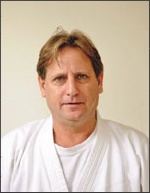
Does Shiatsu treatment help patients who are suffering from cancer?
Can Shiatsu damage and “spread” the cancer metastases all over the body?
These are the two main questions I have been asked during my 35 years of practising & teaching Shiatsu in Japan and all over the world.
In this article I will try to answer these questions and many more.
First of all, I will introduce myself briefly. My name is Tzvika Calisar. I started my way in Shiatsu at the Japan Shiatsu School in Tokyo (with Tokujiro Namikoshi sensei) in 1985, and then at Iokai Shiatsu Centre in Tokyo (the school of Masunaga sensei) and continued to study with a few other Shiatsu methods in Japan. From 2001-2007 I taught shiatsu in Tokyo to Japanese students in a Shiatsu school and treated patients from all over Japan.
During those years I also travelled around the world teaching shiatsu to Shiatsu teachers, therapist & students. So, my experience of treating patients with cancer for 35 years (of course not only with Cancer) are not limited to one or two people, countries, traditions or religions.
I will start with the second question – can Shiatsu damage and “spread” cancer metastases all over the body?
The answer is NO!
30 years ago, many Shiatsu schools around the world taught their students that they SHOULD NOT treat people suffering from Cancer precisely because it can spread metastases all over the body.
I completely disagree with this opinion. On several occasions I have consulted with friends of mine who are Doctors about this and their answer is: “Cancer metastases spread through the blood and physical stimulation will neither speed it up nor slow it down”.
In Shiatsu we do not treat on the physical level but on the Meridian and Ki level. (Massage works on the physical level).
The only problem my Doctor friends mentioned is the following: what if a patient is coming for a treatment with a symptom and didn’t check it beforehand with a Doctor? In that case the patient might feel much better in the moment but the cancer will not have been treated.
The solution to this subject is very simple.
Most patients have already been to their Doctor to check why they have the specific symptoms and if not, you can advise them to go and check it from the Western medical perspective with their doctor.
Now for the first question – does Shiatsu treatment help patients who are suffering from cancer?
The answer is YES!
In the last 10-15 years, Shiatsu treatment for patients diagnosed with cancer is increasingly common in many hospitals around the world. For example, in Israel every public & private hospital now offers Shiatsu in its Oncology department.
There are 3 main types of patients with cancer (any type of cancer) who come for Shiatsu treatments:
1- The first type are patients at different stages of Cancer who are in the beginning or middle of the conventional Western medicine treatment (Chemotherapy, Radiation or Biologic treatments). The main reason and intention for the Shiatsu treatment is to awaken their internal Seiki (meaning Internal healing energy & power) which helps them successfully overcome the hard and difficult treatments. The results are great but I can’t say whether it’s because of the Shiatsu treatments, the conventional treatments or the combination.
We should always recommend them to continue with conventional treatment and not take the risk that they will stop it and receive only Shiatsu or any other Oriental medical method.
A while ago I was treating an American woman suffering from liver cancer and she could not even get up from her bed due to weakness and pain all over her body. After a few Seiki Shiatsu treatments, she almost returned to a normal life without pain (but still with cancer). One day she asked me “If I should recover completely from the cancer, how I will know if it’s because of your Shiatsu treatments or because of the chemotherapy?” I smiled and answered her “Never mind why. The most important thing is that you recover, get healthy and live normally”.
2- The 2nd type of patients coming for Shiatsu treatments are seeking help with reactions to Chemotherapy & Biologic treatments, for example: abdominal pain, diarrhea, muscle cramps, nausea and various other reactions. In these cases, the results are very fast and effective and it is clear that the reason for the improvement is the Shiatsu treatments.
3- The 3rd type of cancer patients who are coming for Shiatsu treatment are those who are in the last few months of their lives, when the doctors in the hospital have given up and told the patient and her/his family that there are only a few months left. In that case, there are basically two kinds of reactions: either starting the process of parting from life & family or trying to fight until the end. For most people “this is the end”, while for others it’s only “one part of a long journey”. In both situations our Shiatsu treatments should focus on helping the patient to depart this life peacefully.
A few years ago, I flew from Japan to Vienna to give a Shiatsu workshop. A student came to pick me up from the airport and in his car on the way to my hotel he began to tell me that his friend who he was treating was in hospital, dying of cancer. His whole family were telling him to fight and that he would be ok. My student asked me advise him how to treat his friend.
I asked him to drive me to the hospital to meet his friend. When we arrived at his room, I looked into his eyes and they showed a great sadness. I talked to him but he could not talk back. His family were pushing me to tell him he would survive but I could not say anything like that. In the car on the way to my hotel, I said to my student “When you treat your friend, do it with the intention that he will pass away peacefully and that his family will support him”. After a few weeks, my student called me and told me that his friend had passed away peacefully.
Concluding remarks:
As a Shiatsu therapist, you should not be afraid to treat patients with cancer. We can treat them at any stage and in any condition because Shiatsu treatment helps them so much.
Just be clear what the purpose of your treatment is:
- Fighting the cancer?
- Balancing Kyo & Jitsu?
- Releasing Jaki (negative energy or stagnation)?
The purpose of Seiki Shiatsu is to awaken the patient’s Internal Healing force/energy – the internal Seiki. In my Shiatsu method, we diagnose and treat the “Seiki Meridian”, meaning one of the 14 meridians (apart from the Kyo & Jitsu meridians) that connects directly to the internal Seiki of the patient. The awakened internal healing force of the patient can do its work very well.
Good luck!
Contact: www.seikishiatsu.org
(To know more about Tzvika, read his interview).
Author: Ivan Bel
English supervisor: Chris McAlister
- A Milestone: The 2025 ESF Symposium in Brussels - 24 March 2025
- Austria – 19-21 Sept. 25: Shiatsu Summit in Vienna – chronic fatigue, burnout & depression - 19 December 2024
- Terésa Hadland interview: Shiatsu at core - 25 November 2024
- Book review: “Another self” by Cindy Engel - 30 September 2024
- Austria – 24-26 Oct. 25: Master Class in Vienna – Shiatsu and martial arts - 20 August 2024
- France – Lembrun Summer Intensive Course – July 6 to 12, 2025: Digestive System Disorders, Advanced Organ Anatomy, and Nutrition - 4 August 2024
